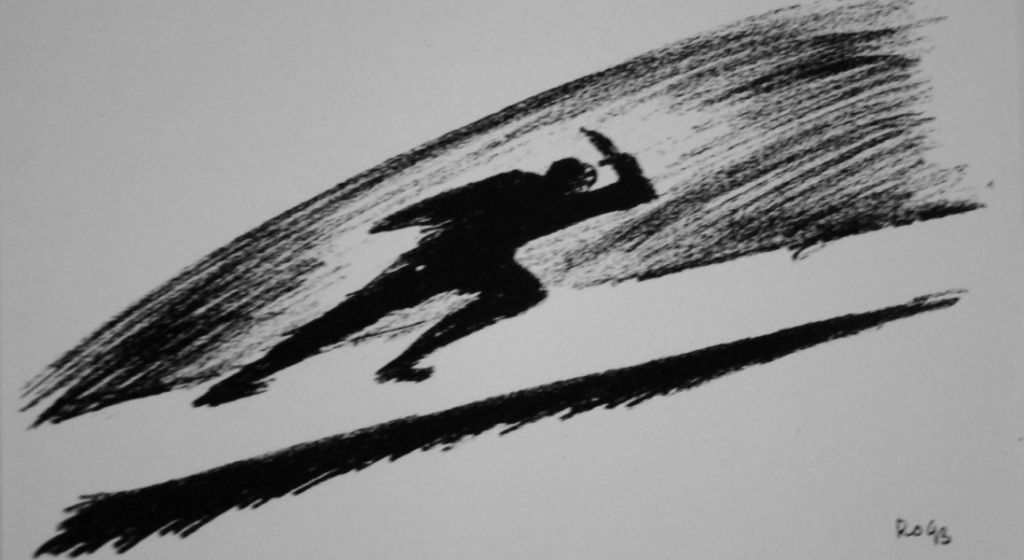Christian Romanowski, It is looking at me
24.4.–15.5.2018.

The ‘It is Looking at Me’ exhibition includes three elements. First is a series of drawings and oil on canvas paintings. The second is books of working drawings created in the process of developing directorial concepts and procedures. Thirdly, the exhibition includes essay films that Romanowski has made over the past three decades.
Christian Romanowski studied acting and directing at the Hochschule für Musik und Darstellende Kunst in Hamburg. He has directed dramas by Dürrenmatt, Fassbinder, Sternheim, O’Casey and Strindberg in the theatres in Marburg, Heilbronn, Wilhelmshaven, Würzburg and Bremen. He is also the author of numerous documentary and feature films (shown on 3Sat and ARTE) on cultural issues. His film essay ‘Ewig werdendes Vergehen – Der Aletsch Gletscher’ was awarded a grand prix at the film festival in Graz in 2003.
In Croatia, he directed Verdi’s opera ‘Don Carlo’ (Croatian National Theatre in Split), Cavalieri’s ‘Rappresentatione di anima et di corpo’ (Zagreb Youth Theatre, Zagreb), the opera-oratorio ‘Oedipus Rex’ by Igor Stravinsky, and a semi-scenic production of ‘Salome’ by Richard Strauss (Vatroslav Lisinski Concert Hall, Zagreb). Besides directing, Romanowski frequently supervises stage design for musical-stage performances. In 2015 he worked as the director and stage and lighting designer for the productions of ‘Inferno’ (music: Milko Kelemen) and ‘Oepidus Rex’ at the Croatian National Theatre Ivan pl. Zajc in Rijeka.
The exhibition is curated by Filip Beusan and Leonida Kovač.
“…Freud, however, took a step further compared to Jentsch’s definition of the uncanny and the unfamiliar, asking how heimlich could become unheimlich. Thereby he emphasized that the word heimlich was itself rather ambiguous, since it belonged to two different, although not contradictory kinds of notions. The dictionary of the Grimm brothers explains heimlich as a “place free from ghostly influences… familiar, friendly, intimate” – which takes Freud back to Jentsch, who identified a source of the uncanny in the impossibility of knowing for sure whether an inanimate object might not be alive after all.
The same uncertainty is evoked by the still-life paintings of Christian Romanowski, where heimlich turns into unheimlich. Moreover, in paintings such as the artist’s self-portrait from 1992 fruit is depicted against an opaque background, the colour of which is almost identical with that of Jocasta’s blood-red dress and the staircase where she is standing shortly before committing a suicide. Instead of her golden clasp, which Oedipus, thrown into the uncanny that is nothing other than himself, uses to deprive himself of eyesight, paintings by Christian Romanowski offer knife blades to our gaze. In this way, the viewer is brought to question the circumstances in which something is recognized as a still life and especially the location of the porous boundary separating the animate from the inanimate.”
Leonida Kovač
“Through the scenes of seemingly untouched nature and those of the landscapes significantly altered by human activity, we are gradually brought to the cognition that nothing is eternal and that even the change itself is, to a certain extent, subject to change. Transience of everything that has been created by human hand helps the nature to gradually accomplish consolatory self-regeneration, sweeping away the traces of human transgression. At the same time, destroying his natural environment, man most probably sows the seed of his own demise. By fascinating images of these vicious circles in which the balance between nature on one side and man on the other is alternately lost and re-established, a viewer is pulled into the depths of nuanced, causal meanings and engulfed in the pure beauty of visual content.”
Filip Beusan